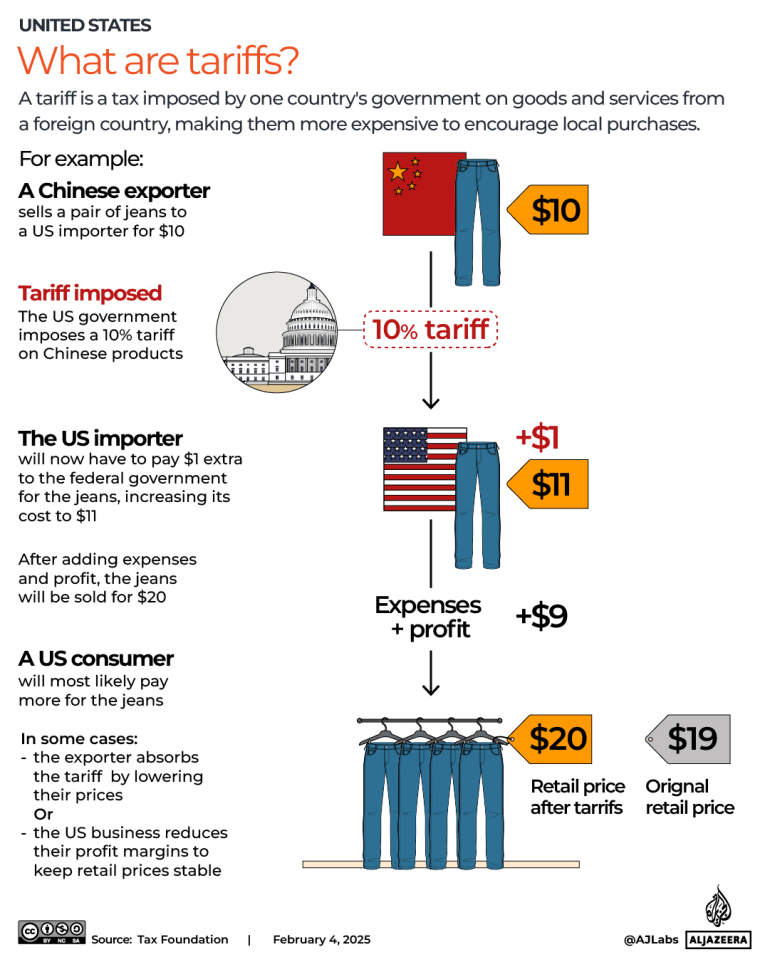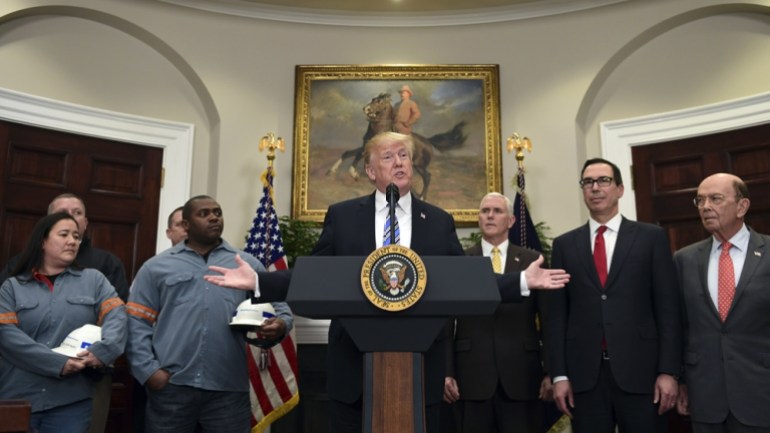United States President Donald Trump has announced plans to impose 25 percent tariffs on all steel and aluminium imports, and reciprocal tariffs on countries levelling duties on US goods.
On Monday, during a signing ceremony at the Oval Office, Trump announced the tariffs on foreign steel and aluminium were to be imposed “without exceptions or exemptions”.
The tariffs are set to come into effect on March 12.
Who are the top suppliers of steel to the US?
Steel is an important material primarily used in construction, manufacturing, transportation and energy sectors due to its strength, durability and versatility.
Roughly a quarter of all steel used in the United States is imported.
Canada, Brazil and Mexico are the top three suppliers of steel to the United States. Between March 2024 and January 2025, they provided about half (49 percent) of steel imports for domestic consumption according to the International Trade Administration.
During that period, Canada supplied 22 percent (5.47 million tonnes) of the 25 million tonnes of steel imported into the United States followed by Brazil with 15 percent (3.74 million tonnes) and Mexico with 12 percent (2.9 million tonnes).
South Korea, Vietnam, Japan, Germany, Taiwan, the Netherlands and China, together as the remaining top 10 steel providers, accounted for 30 percent of US steel imports.
Who are the top suppliers of aluminium to the US?
Canada is by far the biggest supplier of aluminium to the United States. Between March 2024 and January 2025, it provided nearly 40 percent of US imports totalling nearly 3 million metric tonnes according to the International Trade Administration.
The United Arab Emirates, China, South Korea and Bahrain follow Canada in making up the top five aluminium suppliers to the US.
Being a lightweight metal, aluminium is used widely in the automotive and aerospace industry. It is also often used in packaging, especially for food and beverages, due to its ability to preserve contents and its recyclability.
The US is more dependent on imports for aluminium, with roughly half of all aluminium used in the country being imported.
What are tariffs and how do they work?
A tariff is a government-imposed tax on imported goods and services, paid by businesses bringing them into the country.
Designed to protect domestic industries, tariffs often drive up costs for consumers by making foreign products more expensive, potentially reducing demand.
President Trump has said he would implement tariffs on various imported goods to protect US industries, reduce trade imbalances and promote domestic manufacturing.

How did Trump’s first-term tariffs affect US steel?
In March 2018, Trump imposed 25 percent tariffs on steel and 10 percent on aluminium. The idea behind the levies was to reduce reliance on foreign steel and to boost domestic production.
Markets initially responded with a surge in US steel prices and a drop in low-priced imports, which increased profits for domestic companies. However, increased US production led to too much steel in domestic markets. By the end of 2019, steel prices had fallen more than 40 percent, primarily due to retaliatory tariffs from US trading partners, as well as weakening consumption, particularly in the car-making and construction sector.

How does this affect the US steel and aluminium industry?
Steel and aluminium are important materials in the construction and automotive industries as well as being used in making machinery, household durable goods and electronics.
If the tariffs are implemented, the impact on metal trade could be substantial according to a report by the London Stock Exchange Group’s (LSEG) Metal Research team.
Tariffs could potentially raise costs for manufacturers and disrupt established supply chains. While US manufacturers may turn to domestic producers to meet demand, they would likely face higher prices, which could in turn increase costs for industries such as car-making and housing.
How will tariffs affect China?
China dominates the global steel market and is the world’s largest producer, accounting for more than half of global production. As a result, cheaper Chinese steel exports have inundated global markets.
Despite not being a big exporter to the US, China is likely to be affected due to the processing of Chinese steel and aluminium in other countries, such as Vietnam which then enters the US.